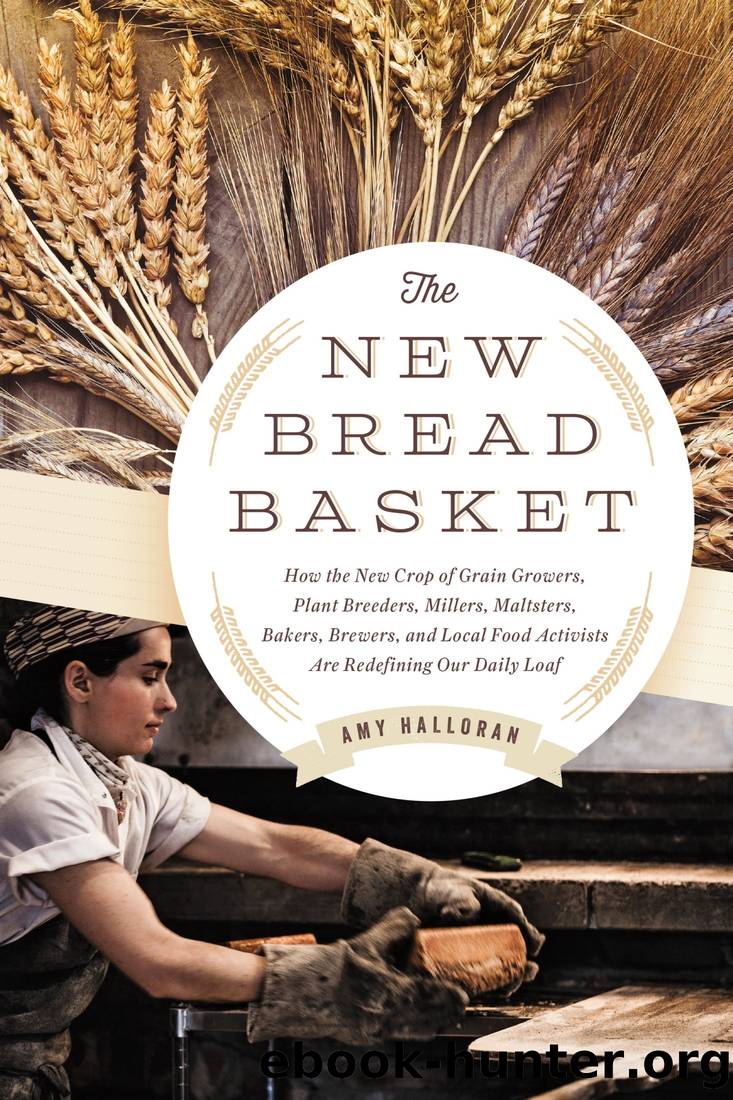The New Bread Basket: How the New Crop of Grain Growers, Plant Breeders, Millers, Maltsters, Bakers, Brewers, and Local Food Activists Are Redefining Our Daily Loaf by Amy Halloran

Author:Amy Halloran [Halloran, Amy]
Language: eng
Format: epub
ISBN: 9781603585675
Google: ZKb0CQAAQBAJ
Amazon: 1603585672
Publisher: Chelsea Green Publishing
Published: 2015-07-15T15:09:23.826218+00:00
Bread Culture is a model of how many things—health, nutrition, and minds—can change when you switch your approach to flour and bread. Mary Parr works from her home kitchen, operating under a cottage food license. Her relationship to bread is a compelling story of reform. She was pretty sick the last few years, suffering from digestive pain. Tests for celiac disease came up negative, but doctors suggested she might find relief by going gluten-free. She swore off bread and gluten, and this, plus acupuncture, somewhat curbed her symptoms.
“I still had stomach pain. I still had to watch every bite,” she said. She was always worrying about when or if her stomach would feel full of pieces of glass.
Mary is studying Chinese medicine, and when she was headed to France for her honeymoon, a friend at school kept telling her to try some bread.
“I was able to eat everything there,” Mary said. “I came back and thought there has to be a way to change this for people. Gluten isn’t an enemy.”
Mary used herself as an experiment, trying to bake bread she could eat. She took a class with Michael O’Malley and started using wild yeasts and long fermentations. After eight months, her digestion has drastically improved. She still can’t eat conventional wheat products, like commercial crackers or cookies made with supermarket flour, but she really feels the difference from eating her own sourdough bread.
“I won’t use anything else but Nan’s flour,” she said. She loves the feel of the flour. Having her hands in the dough, she feels creative again, which is a nice break from the scientific rigors of her master’s program.
Mary thinks the flour is miles away from any alternatives. Freshly milled flours are not oxidized as much as others, and the nutrition is more bioavailable. Another important factor is the sourdough cultures. She believes the probiotics in the bread are a salve. When she runs out of bread and doesn’t eat it for a few days, her stomach woes creep back.
Mary has the zealotry of the healed. Having found a solution, she wants to share her success. She began bringing bread to school simply because she loved baking and had more than she could eat. Once she discovered she could get a cottage food license, she began selling at school, and at Grist & Toll.
Having been mired in big questions about gluten, she is sensitive to the issue. She makes a gluten-free loaf with a gluten-free starter produced from teff flour. She loves the feeling of sharing bread with people who have had to avoid it.
When other people find they can eat wheat bread again, too, it reinforces her belief that all the fuss about gluten is not really about gluten.
“It’s about how we live and how fast we live,” said Mary. Scaling down and slowing down milling, and giving dough a long time to ferment and break down gluten, is critical, she feels, to reviving our relationships to bread and other things. She sees the panic against bread as part of a larger problem.
Download
This site does not store any files on its server. We only index and link to content provided by other sites. Please contact the content providers to delete copyright contents if any and email us, we'll remove relevant links or contents immediately.
| Beer | Cocktails & Mixed Drinks |
| Coffee & Tea | Homebrewing, Distilling & Wine Making |
| Juices & Smoothies | Wine & Spirits |
Whiskies (Collins Gem) by dominic roskrow(42181)
101 Whiskies to Try Before You Die by Ian Buxton(42144)
Whiskies Galore by Ian Buxton(40294)
Craft Beer for the Homebrewer by Michael Agnew(17439)
Right Here, Right Now by Georgia Beers(3493)
Not a Diet Book by James Smith(2715)
Water by Ian Miller(2579)
The Coffee Dictionary by Maxwell Colonna-Dashwood(2527)
Kitchen confidential by Anthony Bourdain(2298)
Coffee for One by KJ Fallon(2002)
Smuggler's Cove: Exotic Cocktails, Rum, and the Cult of Tiki by Martin Cate & Rebecca Cate(1977)
Beer is proof God loves us by Charles W. Bamforth(1914)
Superfood Smoothie Bowls: Delicious, Satisfying, Protein-Packed Blends that Boost Energy and Burn Fat by Chace Daniella(1898)
Talking as Fast as I Can by Lauren Graham(1827)
Bourbon: A Savor the South Cookbook by Kathleen Purvis(1786)
A Short History of Drunkenness by Forsyth Mark(1714)
Eat With Intention by Cassandra Bodzak(1684)
Cocktails for the Holidays by Editors of Imbibe magazine(1623)
Colombia Travel Guide by Lonely Planet(1606)
